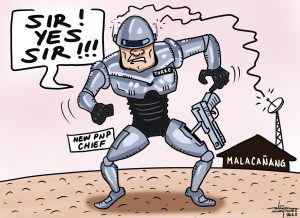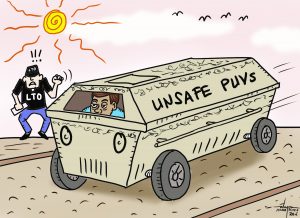WE AGREE with a former high-ranking Department of Public Works and Highway (DPWH) XI regional official that a mass transport system like the Light Rail Transit (LRT) is a much better alternative than adding public utility buses in Davao City’s road network. Yes, the latter will certainly add to the further congestion of the city’s major thoroughfares. Personally though, we believe that the best and less costly solution to the burgeoning vehicular traffic in the city is the construction of new roads in the peripheries of the main business district.
Our preference is based on budgetary consideration as well as on the project’s relatively easier implementation. In our past columns we had been batting for the construction of the planned coastal highway that runs from the shorelines of Sasa down to Sta. Ana to Bucana, Matina Aplaya, Talomo, Bago Aplaya up to either Sirawan or Binugao in Toril.
Another personal unsolicited suggestion is the construction of a second diversion road that will have as its route starting from Bunawan up to Mahayag to Indangan, then take a shortcut to Tigatto going to Waan then to Magtuod moving towards Matina Pangi then to Catalunan Grande down to Catalunan Pequeno then to Toril District. The city can opt to implement the two suggested projects one at a time or simultaneously if interested private parties are willing to foot the cost and operate the same after completion.
Budget wise, we are sure that any of the two infrastructure projects costs much lower than an LRT that runs from either Lasang or Bunawan down to Toril. Moreover, construction of a coastal highway or the diversion road will not have as much disruption as doing the LRT.
Yes, there will be families that will be displaced and houses destroyed if a coastal highway is implemented. But the cost of displacing and relocating the affected residents is peanuts compared to the cost that maybe incurred if an LRT project will be done and passes through the city’s commercial and industrial areas. Then, as soon as work on an LRT is begun it would be very hard to imagine how to cope with the humongous vehicular traffic that it will create. There will be major re-routing when diggings begin. There will be relocation of power and communication lines, as well as water pipes in areas where the LRT traverses.
The railway for an LRT will be constructed straight ahead as much as possible. Therefore, any building and other structures, commercial, industrial or residential that will interfere with the project will have to be taken out. And that is more money needed for the budget.
And there are other costs to be considered. An LRT needs terminal facilities where to load and unload passengers; a garage of sorts for maintenance of its trains. All summed up, the budget for an LRT infrastructure alone is mind boggling. Then add the budget needed to procure the coaches or trains and the calculators will just have to give way to the number of digits of the total amount needed.
Of course if the city government utilizes the Public Private Partnership (PPP) scheme in undertaking an LRT project, it may be able to pass on the cost to the implementing partner who will later operate the project. However, the riding public will be the ones to pay for the cost for as long as eternity.
On the other hand, a coastal road project implemented on the same PPP scheme only needs the city government leaders’ political will to relocate occupants of the city’s shorelines. Most, if not all of these occupants are informal settlers because shorelines are actually not for human habitation and these are government properties. Yes, the coastal road may cross privately owned and titled properties but in terms of area and number of property owners these are not comparable to those that will be affected
by an LRT construction. And there are no terminals to be built; no trains to be bought. It would also be much easier to regulate the users of the coastal road since authorities know exactly which of the many vehicles plying the city have destinations that need not pass the city proper.
The same is true if a second diversion road is constructed instead of an LRT. For certain a diversion highway will cut across private properties but most of these could be agricultural or residential areas.
Thus, the cost of expropriation, if it has to go that far, will be much lower than expropriating properties right in the heart of the city.
In other words, the cost components in both the coastal highway and the diversion road construction will only center on the infrastructure projects and the acquisition of private properties that will be affected. And both projects will immediately result to the appreciation of the values of the real properties being traversed, to the benefit of the owners and of the city in terms of collectible real property taxes, of course. And even if more buses, jeepneys and privately owned vehicles are added yearly, both the two latter projects will substantially reduce the volume of vehicles entering the city proper.
Shortly before Davao City’s and the rest of the country’s economy started getting ravaged by CoViD 19 pandemic beginning last March this year, the local government unit’s choices were already made clear. The coastal highway was well on its way to completion. The new diversion, or call it by-pass road project if you prefer to, already hurdled its technical study requirement phase. In fact of late we read in the papers that an agreement for the funding of the new diversion highway – again, by-pass road if you want –had already been signed with the Japanese government.
So, now fellow Davaoenos, the realization of the here-in-mentioned mega infrastructures could be the thing that could help us look forward to a much better Davao City after the dark days of the CoViD 19 regime.
Meanwhile, let’s set aside thinking of the supposed Phase 1 of the Mindanao Railway System and the
much talked-about LRT.



